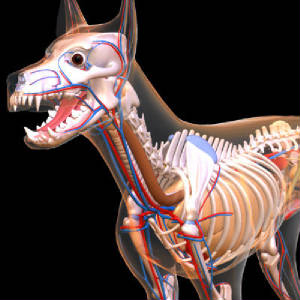|
Respiration

"The respiratory system of a
dog works with the circulatory system to provide oxygen to the body. Dogs inhale through their mouth and nose.
Air travels through the trachea and the bronchus into the lungs. Air intake is controlled by expansion and contraction
of the diaphragm. Most of the space in a dog's thoracic cavity is taken up by the lungs and heart"
Transportation

"The ciculatory system of a dog
is made up of the heart and blood vessels. The heart pumps blood throughout the body. A dog’s activity level
determines its circulation rate. Twenty percent of the blood in the system is in the brain at all times. Blood
flow to other parts of the body is regulated by nerves and hormones. Higher levels of oxygen are provided to the heart
and limb muscles during exercise through increased blood flow to those areas."
How are dogs similiar to humans?
Dogs are similiar to humans in many different
ways. One basic way that they are similiar is that we are both mammals. This means we have many similiar traits. We are both
warm blooded, we have hair insted of feathers or scales, we both give birth to live babies instead of eggs and we both breathe
through lungs. Also, we both get our nutrients by eating other live things. Such as animals and sometimes plants. Finally,
dogs are similiar to us because they have a similiar internal anatomy. They perform life functions like we do. This includes
respiration, transportation, excretion, regulation and nutrition. This is how dogs and humans are similiar.
How are dogs different than humans?
Although dogs are very similiar to humans,
they are also different then us in a few ways. For example, they have different physical characteristics. Such as the fact
that they walk on all four legs, or that they have tails and snouts. Also, they are different beacause some of their senses
are more powerful then humans. This is true for a dogs sense of smell and hearing. They can smell or hear certain things that
most humans cannot. This is how dogs are different than humans.
How do the differences benefit to the organism in its environment?
Although some dogs live in captivity
as pets or in animal shelters, it was not always like this. Thats why dogs have the traits that we see in them. Dogs that
live in the wild must be able to hunt find shelter or territory. This is why its senses and body structure benefit it. Its
kean sense of smell and hearing helps its to locate prey and track it down. Its four legs help it run fast to catch prey that
tries to get away. Also, its longs snouth helps its catch and kill the prey quickly. Its kean senses also helps it detect
danger and get away. Dogs also use smell to sense the territory of another dog. Marking territory is also done through excretion
of liquid waste (urin). The smell of this urin is what alerts other dogs. Dogs also tend to do this in captivity. Most
of the times dogs will mark a spot over others, as in a way of battling for territory. This is how the differences from dogs
to humans help benifit dogs in their environment.
Website created by:
 Shebaz Ali,
 Danny Cokes,  Daniel S.
|

